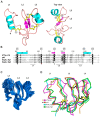An Unusual Two-Domain Thyropin from Tick Saliva: NMR Solution Structure and Highly Selective Inhibition of Cysteine Cathepsins Modulated by Glycosaminoglycans
- PMID: 38396918
- PMCID: PMC10889554
- DOI: 10.3390/ijms25042240
An Unusual Two-Domain Thyropin from Tick Saliva: NMR Solution Structure and Highly Selective Inhibition of Cysteine Cathepsins Modulated by Glycosaminoglycans
Abstract
The structure and biochemical properties of protease inhibitors from the thyropin family are poorly understood in parasites and pathogens. Here, we introduce a novel family member, Ir-thyropin (IrThy), which is secreted in the saliva of Ixodes ricinus ticks, vectors of Lyme borreliosis and tick-borne encephalitis. The IrThy molecule consists of two consecutive thyroglobulin type-1 (Tg1) domains with an unusual disulfide pattern. Recombinant IrThy was found to inhibit human host-derived cathepsin proteases with a high specificity for cathepsins V, K, and L among a wide range of screened cathepsins exhibiting diverse endo- and exopeptidase activities. Both Tg1 domains displayed inhibitory activities, but with distinct specificity profiles. We determined the spatial structure of one of the Tg1 domains by solution NMR spectroscopy and described its reactive center to elucidate the unique inhibitory specificity. Furthermore, we found that the inhibitory potency of IrThy was modulated in a complex manner by various glycosaminoglycans from host tissues. IrThy was additionally regulated by pH and proteolytic degradation. This study provides a comprehensive structure-function characterization of IrThy-the first investigated thyropin of parasite origin-and suggests its potential role in host-parasite interactions at the tick bite site.
Keywords: cathepsin; cysteine protease; parasite; protease inhibitor; protein structure; saliva; thyropin; tick.
Conflict of interest statement
The authors declare no conflicts of interest.
Figures






References
-
- Lenarcic B., Bevec T. Thyropins—New structurally related proteinase inhibitors. Biol. Chem. 1998;379:105–111. - PubMed
-
- Rawlings N.D., Barrett A.J., Thomas P.D., Huang X., Bateman A., Finn R.D. The MEROPS database of proteolytic enzymes, their substrates and inhibitors in 2017 and a comparison with peptidases in the PANTHER database. Nucleic Acids Res. 2017;46:D624–D632. doi: 10.1093/nar/gkx1134. - DOI - PMC - PubMed
MeSH terms
Substances
Grants and funding
- 21-08826S/Czech Science Foundation
- RVO 61388963/Institutional project
- CZ.02.1.01/0.0/0.0/16_019/0000759/Centre for Research of Pathogenicity and Virulence of Parasites, European Regional Development Fund (ERDF)and the Ministry of Education, Youth and Sports of the Czech Republic (MEYS)
- 22-30920S/Czech Science Foundation
- LUC23037/Ministry of Education, Youth and Sports of the Czech Republic (MEYS)
LinkOut - more resources
Full Text Sources

